Inspired spaces
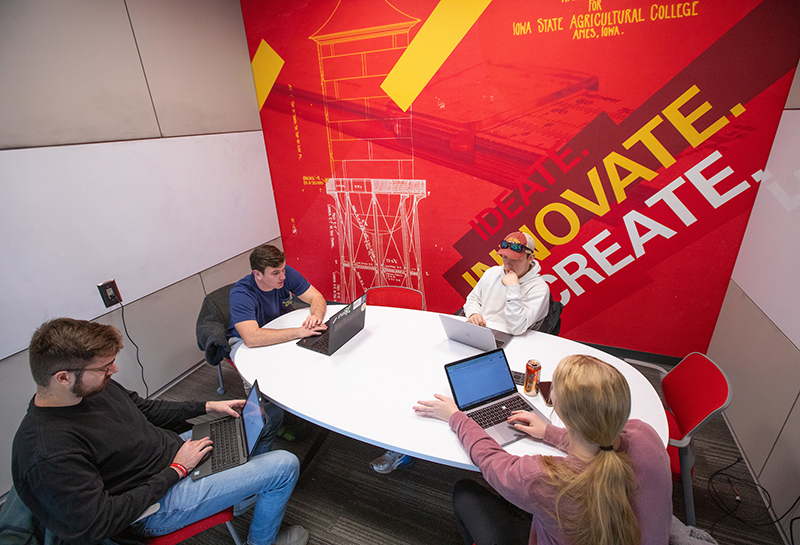
Undergraduates (l-r) Joshua Battles, Daniel Coughlin, Lucas Weigle and Julie Fisher worked on the final project for their Agronomy 342 class Monday afternoon in the Richard Soukup room, one of Parks Library's newly decorated collaboration rooms. Photo by Christopher Gannon.
Seven student study rooms on Parks Library's main floor got a colorful new look this fall. The room branding was a collaborative project by university marketing, university library and several library donors, nearly all of whom are former Iowa State students. The strategy was to connect photos from the library's special collections and university archives (SCUA) with donors' interests. Library director of development Rachael Karriker worked with donors to identify themes for each space. External relations director Nacuya Rucker worked with the special collections staff to identify photos that correlated with those interests and captured different aspects of Iowa State.
Here are a few details about five of the rooms and who they're named for:
- Lois and John Mather. Lois is passionate about education and mentorship. She earned a bachelor's degree in education and retired as an elementary school counselor. The room highlights the mentor relationship between George Washington Carver and Louis Pammel, Carver's professor. SCUA holds many of the original letters shared between the two.
- Steven and Carrie Naber. Both served on the VEISHEA and homecoming committees during their Iowa State years, and Carrie also was a member of the marching band. Images depict tuba players from the band and the old VEISHEA office sign in the Memorial Union, with lyrics from the ISU fight song.
- Linda Shallcross Soukup. The room features Linda's photo in the Bomb and the spines of the yearbooks published while she was here. She's also a former library student employee.
- Richard Soukup. Richard earned a bachelor's degree in civil engineering. The room features a blueprint of the Marston water tower, paired with innovation-focused messages.
- Beth McNeil. Former library dean McNeil (2015-19) is passionate about teamwork and bringing people together. This wall space is narrow and simply reads, "If you want to go fast, go alone. If you want to go far, go together."
Two unnamed rooms feature photos of Parks Library's central staircase and current and past photos of the library, originally housed in Old Main. Iowa State students may reserve the group study rooms online.
Juniors and seniors again show up big for winter session
Two weeks from the start of Iowa State's second winter session, 1,878 undergraduates are enrolled in one of the 54 online courses being offered. Approximately 80% of them are juniors or seniors, said Ann Marie VanDerZanden, associate provost for academic programs who, with College of Liberal Arts and Sciences dean Beate Schmittmann, co-chairs the winter session executive planning committee.
"We knew students had more things going on this winter -- travel opportunities, for example -- that might make a winter session less interesting to them, so these numbers are fantastic," said VanDerZanden.
Last winter's pilot, a five-week session, enrolled 2,100 students, but she noted there were greater limitations for holidays, internships and vacations at that pre-vaccination point in the COVID-19 pandemic.
Because this is year two of the pilot, one goal was to maintain consistency in the parameters -- eligibility, number of courses offered, number of credits permitted, etc. -- to be able to make year-over-year comparisons as the model is tweaked and improved, she said.
Courses are filling
Taking their lead from last winter's enrollment data -- more than 70% enrolled then were upperclassmen -- colleges offered more courses this winter for juniors and seniors. About half of this winter's courses are 300-level or 400-level classes.
Since winter course registration opened Oct. 20, 14 courses have filled and another six have single-digit seats available. Four courses were dropped in late November due to low enrollments, giving those students time to register for another course if they chose. VanDerZanden said they're watching a few other courses with low enrollments that might be dropped before Dec. 20, the first day of winter session.
Winter session concludes with final exams on Friday, Jan. 14. Since Gov. Kim Reynolds declared Dec. 23 an additional paid holiday for state employees, four university holidays now fall during winter session: Dec. 23, 24, 27 and 31. The reality is that a condensed, four-week term doesn't provide much wiggle room for days off.
"We know that to achieve an adequate amount of time and effort, winter session will require our students to be working weekends and holidays," VanDerZanden said.
Student services units across campus will remain open over winter break, except for the four holidays. Hours of operation and service mode (in person or virtual) may vary. VanDerZanden said staff in the Academic Success Center are contacting all students enrolled in winter session prior to Dec. 20 to make them aware of available support resources.
The provost's office and Center for Excellence in Teaching and Learning led an optional session for winter instructors Nov. 29. It featured a panel of instructors who taught during the first winter pilot and offered guidance and practical advice for helping students succeed in the accelerated learning window.
P&S Council gets update on compensation changes
Increases to the minimum pay rate in a handful of entry-level pay grades provided about 200 employees with a raise this month, vice president for university human resources (UHR) Kristi Darr told the Professional and Scientific Council at its Dec. 2 meeting.
The pay rate increases were effective Dec. 1 and lift the hourly rates for affected positions to at least $15, prompted by rising entry-level salaries in the Ames area and hiring challenges, Darr said.
"The market in Ames in the last few months has been a bit of a roller coaster. In my career, I haven't seen anything like it," she said.
The minimum salary for P&S pay grade 803 increased from $26,627 to $31,200, which on a full-time, 40-hours-per-week basis is equivalent to a raise from $12.80 per hour to $15. P&S grade 804 increased from $29,955 to $32,240, equivalent to an increase from $14.40 per hour to $15.50. The P&S salary matrix includes two lower pay grades, 801 and 802, but 802 currently isn't being used by any job classifications and an increase wasn't necessary for 801, Darr said.
Minimum rates in three merit pay grades were raised, according to a Darr memo sent to administrative officers last month. The minimum hourly wage for merit pay grade three increased from $13.74 to $15. Pay grade four increased from $14.34 per hour to $15.25 and pay grade five from $15 per hour to $15.50.
In addition to boosting recruiting and retention, the increases simplify the university’s compliance with a federal executive order, which will require workers paid by certain federal contracts to make at least $15 per hour. The requirement is effective Jan. 30, 2022.
The average hourly student wage on campus is $11.36 per hour and is set by hiring managers. Supervisors of student employees should evaluate local market conditions and consider higher pay, if needed, Darr said. The new federal rules also may apply to some student employees.
Speedy changes
Council past president Sara Parris, associate director of the Thielen Student Health Center, said she recently worked with UHR to raise their entry-level pay rate based on exceptional qualifications, and she was impressed by the speed of the process.
"I've never seen the university moving so fast in raising compensation," she said.
Darr credited the responsiveness to UHR compensation analysts Whitney Grote and Nathan Covington but noted that the currently heavy workload for their two-person department may at times require prioritizing those sorts of requests.
Adjustments planned
When a new classification and compensation system for P&S employees launched in September 2020, UHR leaders said it would be regularly updated to keep the market-driven structure current.
"We promised not to set it and forget it," Darr said. "We're really living up to that."
After more than a year working with the system, updates are in the works. After reviewing benchmarking data for -- so far -- about 70% of positions, recommendations are coming soon for changes to the pay matrix and for reassigning some job profiles to higher pay grades. The matrix changes are expected to be announced in January and effective for new hires by February. Job profile adjustments are expected to be announced in March and effective for new hires by April.
Historically, matrix changes have been made as the new fiscal year begins July 1, but an earlier timeline gives budget leaders more time to plan, Darr said. The adjustments require state Board of Regents approval. Employees who make less than the minimum due to an adjustment would be raised to at least the minimum salary no later than Oct. 1.
Other notes
- Jahmai Fisher, chair of the council's equity and inclusion committee, said a motion would be presented at January's council meeting recommending that advertisements for university jobs include information about whether candidates would be eligible for immigration sponsorship. Many employers include this information in job advertisements, and Fisher said not including it hurts recruitment of international applicants.
- Darr said more than 760 applications were submitted for the new WorkFlex program, which allows staff flexibility in where, when and how they work, if it makes sense for their job duties and the university's mission. Hiring authorities have until Dec. 22 to decide how to handle staff requests. That deadline had been Dec. 23 but was moved up a day because Dec. 23 is now a university holiday, she said. WorkFlex arrangements can take effect beginning the first day of the spring semester, Jan. 18.
- Senior vice president and provost Jonathan Wickert said senior leaders are keeping a close eye on the omicron variant of COVID-19. While practices such as wearing masks, physically distancing and hand-washing are effective, he reiterated that vaccination is the key preventive measure and encouraged faculty and staff to register their vaccination status via Workday. Registration is voluntary and confidential. While initially implemented in preparation for a federal executive order that's currently pending due to court challenges, vaccination registration improves the university's situational awareness, Wickert said. In partnership with Hy-Vee, a vaccine clinic will be available to Iowa State employees and students at State Gym Dec. 15.
Campus vaccine clinic set for Dec. 15
Dec. 13 editor's note: All appointments have been reserved for the Dec. 15 vaccine clinic at State Gym. Other vaccine options are available at vaccines.gov, text your ZIP code to 438829, or call 1-800-232-0233 to find locations near you. The university is working with Hy-Vee to offer another clinic after spring semester starts.
Iowa State is partnering again with Hy-Vee to offer a COVID-19 vaccine clinic at State Gym Wednesday, Dec. 15 (9 a.m.-5 p.m.). Hy-Vee will have the Pfizer vaccine (first, second, third doses and booster shots) as well as the flu vaccine available for ISU faculty, staff and students.
The Centers for Disease Control and Prevention recommends that anyone 18 years and older get a COVID-19 booster shot. Clinical trials have shown boosters increase immunity.
Schedule a time online
Use the links below to schedule an appointment online. Appointments must be scheduled by noon on Dec. 14. While there is no cost for the COVID-19 vaccine, participants will need to upload their insurance information when they schedule an appointment to cover administrative fees. A copay may be required for the flu shot.
Thielen Student Health Center also offers daily vaccine clinics for undergraduate and graduate students. More information is available on the COVID-19 Vaccinations website.
A path for sharing inclusion good ideas, successes
by Breehan Gerleman, College of Engineering communications, and Heather Sauer, College of Design communications
The addition of college "champions" to ISCORE (Iowa State Conference on Race and Ethnicity) in 2016 spurred growth in two directions: higher faculty and staff participation in the annual March conference and a clearer path for colleges to share innovative projects, achievements and best practices -- and integrate their efforts, where appropriate. The champions program involves all eight colleges and the library, two at a time. Last spring, ISCORE 2021 featured the colleges of Design and Engineering, each for the second time, and that rotation is just about right, said Japannah Kellogg, who directs the NCORE-ISCORE office. The intent is that students see their college held up at least once during their Iowa State years, he said.
ISCORE champions create local space and time for conversations about issues and policies related to diversity, equity and inclusion (DEI); support and celebrate employee and student research on related topics; develop professional development opportunities for their faculty and staff; and, through attendance and financial assistance, support the ISCORE conference and its national precursor, NCORE. The conference provides the deans of that year's champion units with a chance to share what they're working on.
"We hope the work is a continuum for all of our past and current champions," Kellogg said. "They're never not doing the work. The conference gives champions the time to update us on where they're at."
Design champion
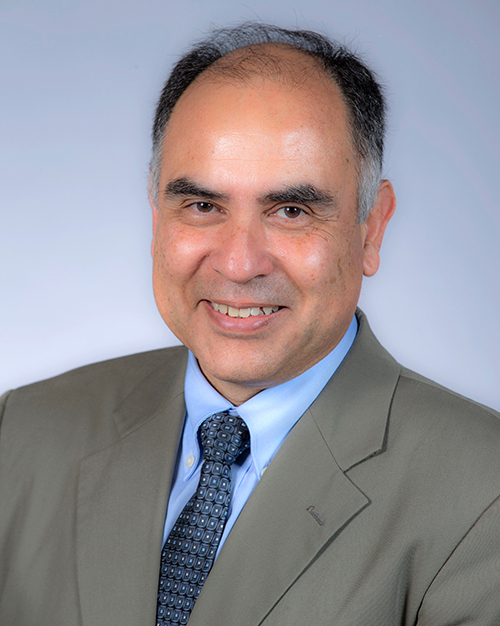
Rico-Gutierrez
"We value our partnership with ISCORE and appreciate the impetus it provides to push our efforts forward," said Luis Rico-Gutierrez, dean of the College of Design. "We represent myriad backgrounds, disciplines, perspectives and interests, and we embrace the opportunities this provides for innovation and collaboration."
Over the past year, the College of Design integrated DEI with many of its audiences through these initiatives:
- Hosted working retreats for faculty and staff on increasing representation in curricula and reducing barriers to serving students from various backgrounds.
- Aligned interdisciplinary option studios -- spring-semester electives for juniors, seniors and graduate students -- with the United Nations' Sustainable Development Goals, emphasizing the elimination of poverty and hunger; gender equality; decent work and sustainable cities and communities.
- Established the first Design United Award, a scholarship for undergraduate leaders in DEI and social justice.
- Increased the Design Closet's capacity to support students with limited financial resources.
A good idea gets better
Former multicultural liaison officer Audrey Kennis established the Design Closet for first-year Design students who can't easily afford the required supplies, providing them with recycled and gently used materials donated by other students, staff and faculty. When he joined the college in spring 2019 as director of equity, inclusion and multicultural student success, Jordan Brooks worked with colleagues to increase the Design Closet's impact through crowdfunding campaigns with the ISU Foundation. As a result, the college is able to subsidize the cost of specialized supplies by assembling kits for students or providing gift cards to the Design Store, a branch of the ISU Book Store.
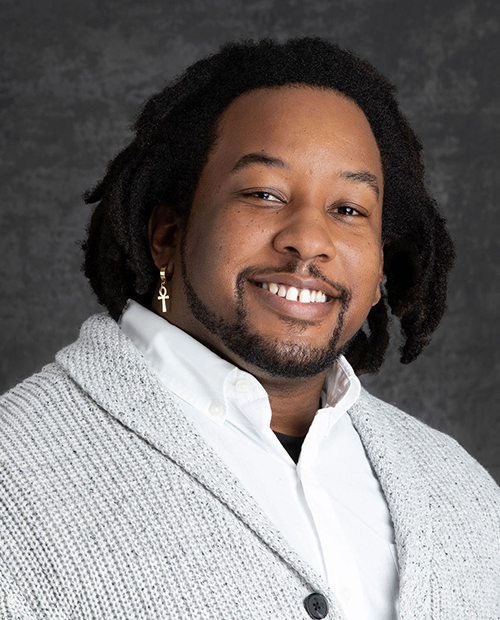
Brooks
Last year, Brooks extended Design Closet support to include student attendance at conferences and workshops, and entry in art and design competitions. This year, he arranged a job fair to connect students with employment opportunities within the college.
"The goal is to be a conduit for students' success and not an obstacle," Rico-Gutierrez said. "We're working to increase access and diversity in the design disciplines, support student growth and achievement, and build a diverse network of future leaders in the design professions."
Engineering champion
Diversity and inclusion efforts in the College of Engineering in recent years added learning outcomes in coursework, a best practices document to support and celebrate department- and individual-level efforts, and essay questions to its college scholarship application that are scored on strength and quality of narratives. With these efforts, an active college diversity committee and a collegewide program that focuses on helping underrepresented students succeed (Leadership through Engineering Academic Diversity), last year the College of Engineering received the highest honor available in the American Society for Engineering Education's Diversity Recognition Program, a status that's valid for three years.
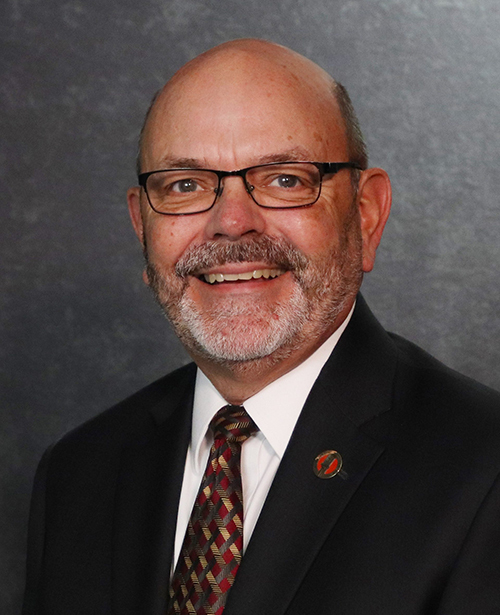
Easterling
"We're proud to be among the nation's top colleges of engineering in inclusive excellence, and supporting programs like ISCORE is a key part of our work as Cyclone engineers," said W. Samuel Easterling, James L. and Katherine S. Melsa Dean of Engineering. "But we're most focused on what's next: Continuing to expand the college's commitment to diversity, equity and inclusion."
With that goal in mind, Easterling created the position of associate dean for equity and engagement. Longtime Iowa State leader in broadening access to STEM, Connie Hargrave, started in the new position in July.
Hargrave will direct growth in college DEI efforts, lead recruitment and retention strategies to ensure access and equity, and foster an inclusive learning and working environment.
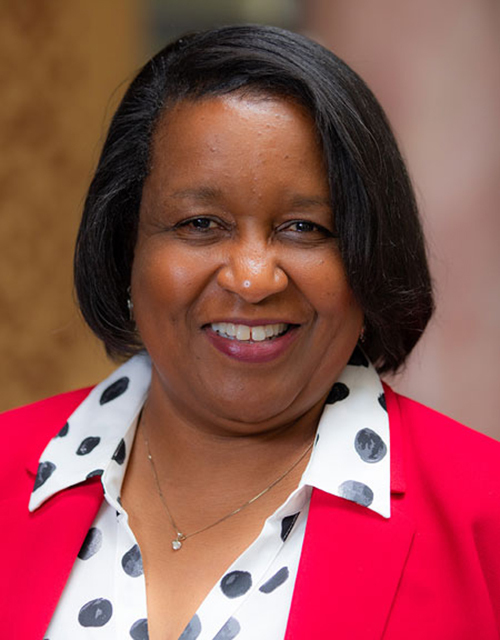
Hargrave
"Our biggest opportunities are with our students -- current and future," Hargrave said. "The college is well-positioned to expand our current students' DEI knowledge and skill sets so they are prepared to be contributing members of diverse technical teams in industry.
"And we are poised to make impactful connections with secondary students from diverse backgrounds through outreach, recruitment and enrollment," she continued. "I have spoken with many faculty who are motivated and hungry to engage and support the next generation in earning their degrees in engineering -- so Cyclone engineers can be the innovators and creative problem solvers we need."
Finance dashboard saves time, assures accuracy
A new dashboard in Workday for cost center managers and grant coordinators stores in one place the reports, tasks and links they use most frequently, erasing time spent searching and assuring they're using the most recent version.
The dashboard, known as FORT (Finance Officers Reports and Tasks), has its own announcements section, where this group of about 200 strategic finance employees receives timely updates specific to their duties in Workday. It also provides links to external sources, including training and policy documents and ISU Foundation financial reports.
Learn more
FORT introduction (video)
How to access FORT
FORT, which addresses some challenges voiced in last January's survey of Workday users, is part of the university's commitment to continuously improving the Workday platform for finance and human resources launched in July 2019.
FORT's reports and tasks existed previously, but with separate dashboards for procurement, sponsored programs administration or financial reporting, for example, finance officers were spending too much time locating what they needed to do their jobs, said Rachael Gross, operations manager for the operations and finance division and part of the 11-member team that developed FORT. Features in Workday's quarterly update for clients in September made a comprehensive dashboard possible, she said.
"I am so proud of the collaborative effort to develop and implement tools such as the FORT dashboard," said Heather Paris, associate vice president for central finance and finance delivery. "As part of our commitment to the continuous improvement journey with Workday and service delivery, our teams will work diligently to identify solutions to streamline access to financial information for decision-making across our campus community."
Better for everyone
With the easier access, FORT significantly shortens users' response times to the faculty and staff they serve. When a researcher asks for a grant balance or a department chair inquires about details on a transaction, they should receive a faster response based on current, accurate data.
Finance officers who add FORT to their Workday landing page receive access only to the reports and tasks they are cleared to use, keeping their dashboard as simple and helpful as possible. For reports they use quarterly or annually -- and may not easily recall their name -- the dashboard is especially helpful, Gross said.
Continuous improvement
The team that developed FORT meets biweekly to review additional tweaks to the dashboard and draft announcements. A current project is to write descriptions for each report in the dashboard to guide users to the best report for their needs.
"The amount of work going into making this a great resource is immense," Gross said. "Our team is continually looking at ways to improve the dashboard for their benefit."
Users of the FORT dashboard also are encouraged to email feedback, questions and suggestions to finance_delivery@iastate.edu.
Extension expands impact with language translation efforts
ISU Extension and Outreach serves as many Iowans as possible through its four educational areas.
One practical way to achieve that is by translating extension offerings into Spanish and other languages. Many of them are available through the extension store website for download or purchase.
Human sciences extension recently unveiled its strategic sustainability plan, Journey 2030. It expresses the desire to expand its reach to groups that historically were excluded or experience limited access to educational opportunities across the state. There are nearly 60 human sciences publications available in Spanish, such as Spend Smart. Eat Smart series.
Agriculture and natural resources extension produces a newsletter in Spanish along with numerous Spanish podcasts. It also has programming in multiple languages -- including Swahili -- for various communities.
Iowa 4-H youth development works to reach Spanish-speaking families through the CONNECT program to provide a gateway into 4-H. It's also developing an all-Spanish website for the program, and recently hired an AmeriCorps member to assist in a range of communication efforts.
Community and economic development extension offers a business planning course for Spanish-speaking entrepreneurs and partners with the Small Business Development Center to provide counseling. It also has a specialty crop processing toolkit available to farmers in multiple languages.
The 2020 census showed how the state's makeup continues to shift. The percentage of Iowans who identified as Hispanic or Latino was 6.8% (215,986) -- the state's largest minority group for the third consecutive census -- and the number who identified as nonwhite, multiracial, or Hispanic or Latino was 17.3% (552,268), according to community and economic development extension.
"Thinking about and serving all Iowans is front and center in our new strategic plan," said Deb Sellers, human sciences extension director. "We have done work in this space for a long time -- and we have made great progress -- but we also are aware that demographics are changing in Iowa and there is more we can do."
Growing need
Human sciences extension offers about 12 programs in Spanish, and has delivered some in French, Mandarin and other languages.
It has worked with a vendor for more than 15 years to translate publications aimed primarily at adult audiences, though it also collaborates with 4-H.
"We translate, as needed, if we have a program we are delivering so materials are available in both English and Spanish," said Kristin Taylor, creative projects specialist for human sciences extension.
Extension relies on employees in communities they serve to request materials or programs that would be most useful with translation, Taylor said.
ServeSafe is one of the programs delivered in Spanish at locations across the state, including people incarcerated in correctional facilities, to help people qualify for jobs and perform duties safely. Participants learn best practices related to safe food handling, cleaning and sanitizing, and other food safety essentials. They are aided through a series of videos in Spanish.
"We do know that Spanish speakers who take ServeSafe are passing and receiving the certification," said Barbara Woods, human sciences extension program specialist.
One of the newest programs is Salir Adelante, which helps Iowa Latinx families with middle schoolers prepare for college and career goals.
Over the past year, human sciences extension also helped train 21 bilingual family liaisons with the Des Moines Public Schools through the Strengthening Families Program. It is for parents and youth ages 10 to 14. The liaisons use more than 10 lanuages to develop meaningful relationships between the school district and the communities they serve, said extension special project manager Barbara Woods.
"They work directly with the families to help build that relationship between parents and children for better function during formative years," said Woods. "It is presented in a language that useful to the family."
Sellers said human sciences extension measures its engagement with Iowans through direct contact when educational information is exchanged. In a typical year that number is above 100,000, and even with the effects of the pandemic more than 89,000 contacts occurred over the past year.
Progress
Extension also has undertaken a multiyear effort to ensure that documents in its online store are accessible to everyone, including individuals with disabilities. The eAccessibility Initiative goal is to convert more than 2,000 titles and more than 27,000 pages of content. About 55% of the titles and 48% of the pages have now been made accessible, said extension store manager Chris Johnsen.
"Initially, we spent eight to nine hours per page making things accessible," he said. "Now we are under an hour. There are now 857 titles available in the store that prior to this initiative, people who needed the accommodations would not have been able to read them."
